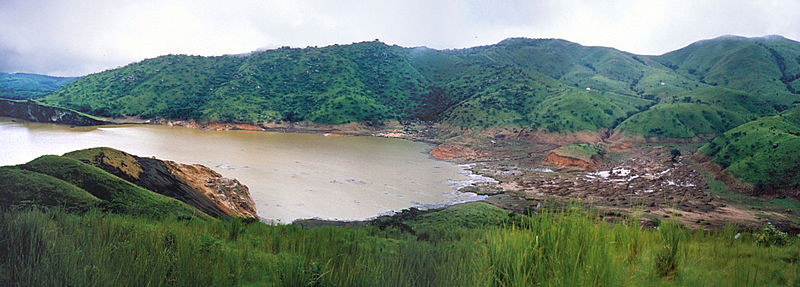Imagine this for a teaser for CSI: The camera opens on a lake with a single party boat on the warm, summer waters. The fifty people on board are having a good time, drinks are being poured, and then a fight breaks out. Everyone gathers around as two guys trade blows while a girl begs them to stop. Suddenly, both the guys start gasping for air, then everyone else starts feeling lightheaded. Before too long, all the party-goers have suffocated. Slowly, the camera zooms out to show how isolated the boat is, the only one on the lake, and then the theme song kicks in.
Think it’s just TV? Think again. On August 21, 1986, approximately 1700 people died in a similar manner.
Shown above via Wikipedia, Lake Nyos is a crater lake in Cameroon, Central Africa. It’s located on the flank of an inactive volcano and below it lies a pocket of magma. This magma continuously leaks carbon dioxide that then dissolves in the lake, creating carbonic acid. The lake serves as a reservoir for the carbon dioxide and also mediates the carbon dioxide’s release, letting it out in a fairly even stream. On that fateful night in 1986, probably because of a landslide, that stream became a torrent.
A CO2 bubble formed in the south of the lake, rising rapidly from the bottom to the top before being expelled at 100 km per hour. The ensuing turbulence around the burst would have destabilized the rest of the lake, thereby releasing most of the stored gas. This runaway reaction released around 1 cubic kilometre of carbon dioxide (1 trillion litres or four hundred thousand Olympic swimming pools), and as CO2 is heavier than air, it flowed across the land and settled in nearby valleys. Unfortunately, many of these valleys contained villages.
How did people react? The rapid escape of CO2 probably started around 9:30 at night, so most people were asleep at the time and died without trauma. For those that were awake, they would have heard something like thunder in the distance when the landslide occurred, and then very little else. Carbon dioxide is colourless and odourless, though other gases released by the magma, such as hydrogen sulfide (the smell of rotten eggs) are not. This means they probably smelt the hydrogen sulfide as their breathing became worse and they gasped for air. One survivor, Joseph Nkwain recounts his experience:
I could not speak. I became unconscious. I could not open my mouth because then I smelled something terrible . . . I heard my daughter snoring in a terrible way, very abnormal . . . When crossing to my daughter’s bed . . . I collapsed and fell. I was there till nine o’clock in the (Friday) morning . . . until a friend of mine came and knocked at my door . . . I was surprised to see that my trousers were red, had some stains like honey. I saw some . . . starchy mess on my body. My arms had some wounds . . . I didn’t really know how I got these wounds . . .I opened the door . . . I wanted to speak, my breath would not come out . . . My daughter was already dead . . . I went into my daughter’s bed, thinking that she was still sleeping. I slept till it was 4:30 p.m. in the afternoon . . . on Friday. (Then) I managed to go over to my neighbors’ houses. They were all dead . . . I decided to leave . . . . (because) most of my family was in Wum . . . I got my motorcycle . . . A friend whose father had died left with me (for) Wum . . . As I rode . . . through Nyos I didn’t see any sign of any living thing . . . (When I got to Wum), I was unable to walk, even to talk . . . my body was completely weak.
To stop anything like this from happening again, a floating platform has been placed in the lake with a pipe extending downwards. The platform then pumps the water from the bottom of the lake (which has more dissolved CO2) to the surface where it’s sprayed out and the gas is released. This continual degassing of the lake should prevent any further tragedies.
Today’s Tangent: It’s not just carbonated lakes that can kill you; at least eight people were killed by a flood of beer. On October 17, 1814, a huge vat ruptured at the Meux and Company Brewery in St. Giles, London, England. The wave of beer that was released ruptured more tanks until they were all broken, unleashing around 1.5 million litres of beer upon the town. Nearby basements quickly flooded and many people were shoved against walls or buried under debris, leading to at least eight deaths.
